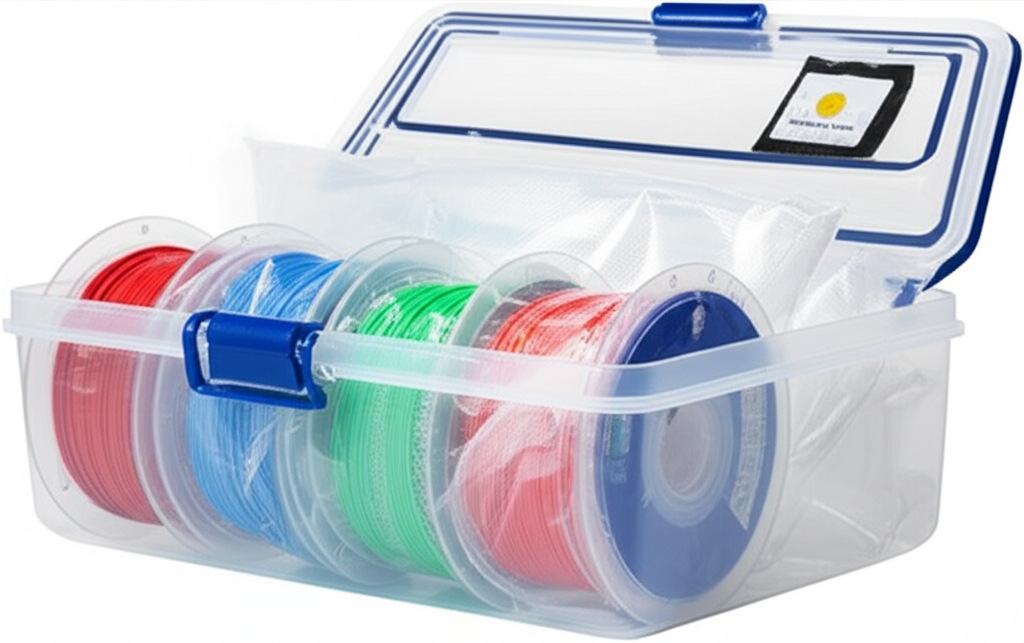Care
How to Properly Store 3D Printer Filament
Andrew Smith
January 15, 2024
5 min read

Proper filament storage is critically important for quality 3D printing. Improperly stored material can absorb moisture, lose properties, and lead to printing problems. In this guide, we'll cover all aspects of proper storage.
Main Threats to Filament
Moisture Absorption
Consequences:
- •Bubbles during printing
- •Poor layer adhesion
- •Uneven surface
- •Nozzle clogging
Vulnerable Materials:
PLA
PETG
Nylon
PVA
UV Degradation
Consequences:
- •Color change
- •Loss of strength
- •Material brittleness
Vulnerable Materials:
PLA
ABS
PETG
Temperature Changes
Consequences:
- •Spool deformation
- •Diameter changes
- •Internal stress
Vulnerable Materials:
All types
Storage Methods
Vacuum Bags
$5-10
Long-term storage
Advantages:
- ✓Maximum moisture protection
- ✓Compact storage
- ✓Transparency
Disadvantages:
- ✗Single-use
- ✗Can damage spool
Airtight Containers
$15-30
Active use
Advantages:
- ✓Reusable
- ✓Protection from damage
- ✓Easy access
Disadvantages:
- ✗Take up more space
- ✗More expensive
Dry Boxes with Heating
$50-150
Professional use
Advantages:
- ✓Active drying
- ✓Humidity control
- ✓Professional solution
Disadvantages:
- ✗High price
- ✗Consume energy
Step-by-Step Storage Guide
Proper Storage Algorithm:
- 1Preparation: Make sure the filament is dry. If necessary, dry it in an oven at 40-50°C for 4-6 hours.
- 2Add desiccant: Place silica gel packets (2-4 per spool) in the container.
- 3Sealing: Place the spool in an airtight container or vacuum bag.
- 4Labeling: Mark the packaging date, material type, and color for convenience.
- 5Placement: Store in a cool, dry place away from direct sunlight.
Storage Conditions by Material Type
| Material | Humidity | Temperature | Special Notes |
|---|---|---|---|
| PLA | <40% | 15-25°C | Moisture sensitive |
| ABS | <60% | 15-30°C | Less sensitive |
| PETG | <45% | 15-25°C | Medium sensitivity |
| TPU | <50% | 15-25°C | Avoid compression |
| Nylon | <20% | 15-25°C | Very hygroscopic |
Signs of Spoiled Filament
Visual Signs
- • Color change or cloudiness
- • White residue on surface
- • Brittleness and breakage
- • Spool deformation
Printing Problems
- • Bubbles and popping during extrusion
- • Poor layer adhesion
- • Uneven surface
- • Nozzle clogging
Restoring Wet Filament
Drying Methods:
Oven (budget method):
- • PLA: 40-45°C, 4-6 hours
- • ABS: 60-70°C, 2-4 hours
- • PETG: 65-70°C, 4-6 hours
- • Use a thermometer for control
Food Dehydrator (recommended):
- • More precise temperature control
- • Even heating
- • Safe for spools
- • Can dry multiple spools
Conclusion
Proper filament storage is an investment in the quality of your prints. By spending a little time and money on storage organization, you'll save a lot of time troubleshooting printing problems and get consistently high-quality results.
Practical Tip
Keep a filament storage log with packaging dates and conditions. This will help track shelf life and the effectiveness of different storage methods.